Contemporary Developments in Employment Relations
VerifiedAdded on 2023/03/29
|20
|5114
|412
AI Summary
This document discusses contemporary developments in employment relations, including the indeterminacy of employment relations, factors affecting employment relations, and the difference between unitarism and pluralism approaches. It also explores the features of employment contracts and sources of employment legislation and development. Additionally, it provides advice on the purpose and scope of statutory trade union recognition.
Contribute Materials
Your contribution can guide someone’s learning journey. Share your
documents today.
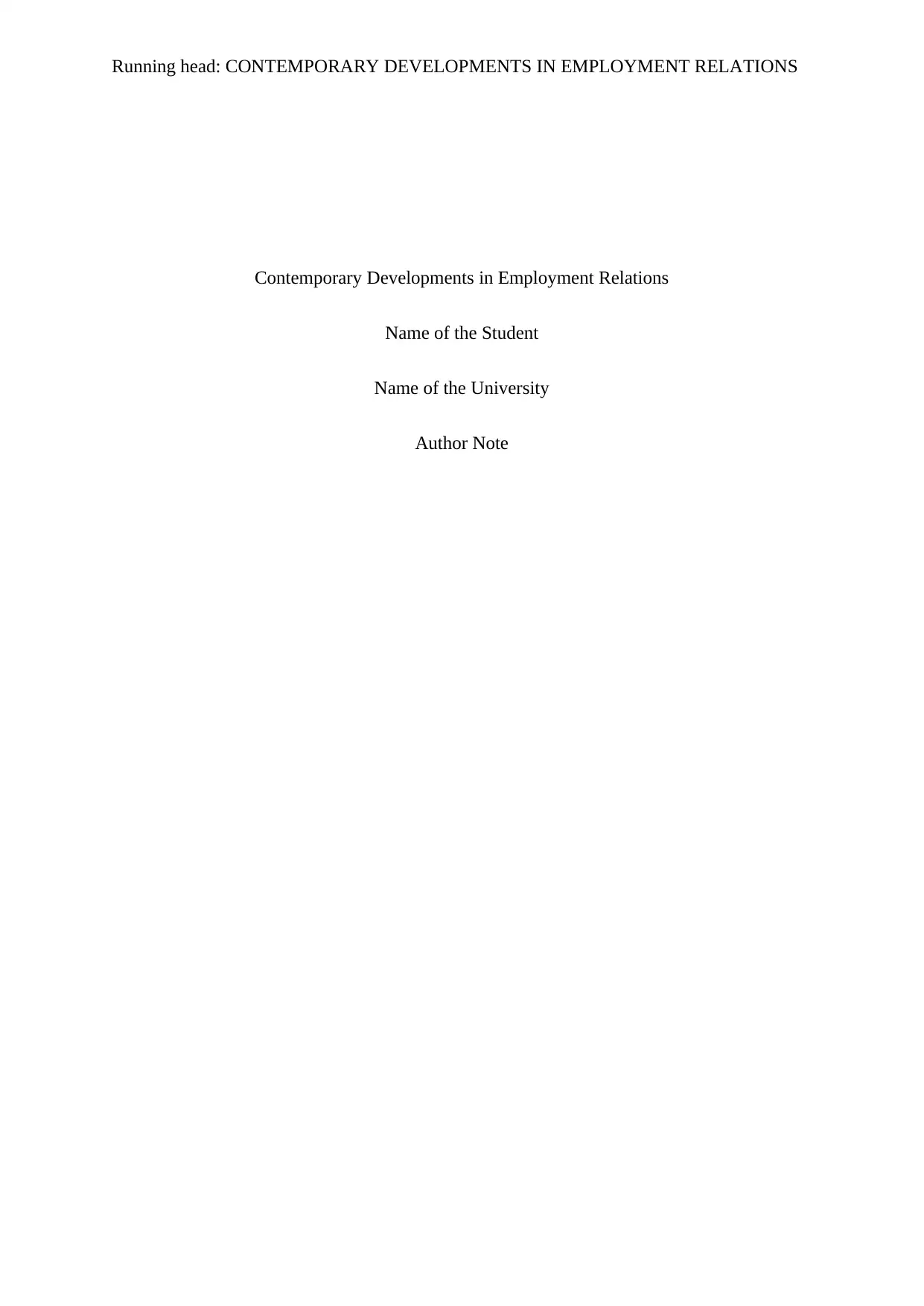
Running head: CONTEMPORARY DEVELOPMENTS IN EMPLOYMENT RELATIONS
Contemporary Developments in Employment Relations
Name of the Student
Name of the University
Author Note
Contemporary Developments in Employment Relations
Name of the Student
Name of the University
Author Note
Secure Best Marks with AI Grader
Need help grading? Try our AI Grader for instant feedback on your assignments.
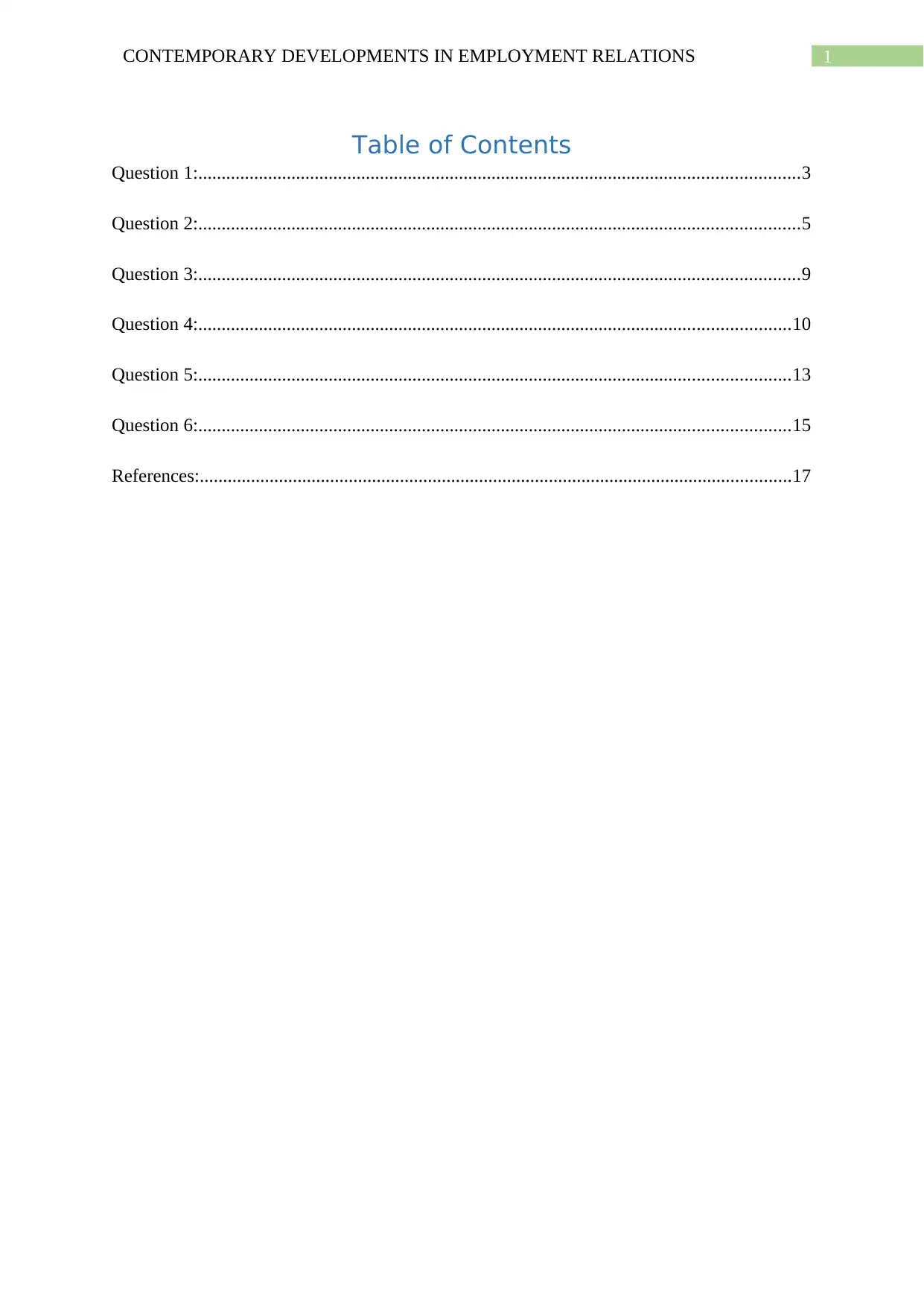
1CONTEMPORARY DEVELOPMENTS IN EMPLOYMENT RELATIONS
Table of Contents
Question 1:.................................................................................................................................3
Question 2:.................................................................................................................................5
Question 3:.................................................................................................................................9
Question 4:...............................................................................................................................10
Question 5:...............................................................................................................................13
Question 6:...............................................................................................................................15
References:...............................................................................................................................17
Table of Contents
Question 1:.................................................................................................................................3
Question 2:.................................................................................................................................5
Question 3:.................................................................................................................................9
Question 4:...............................................................................................................................10
Question 5:...............................................................................................................................13
Question 6:...............................................................................................................................15
References:...............................................................................................................................17
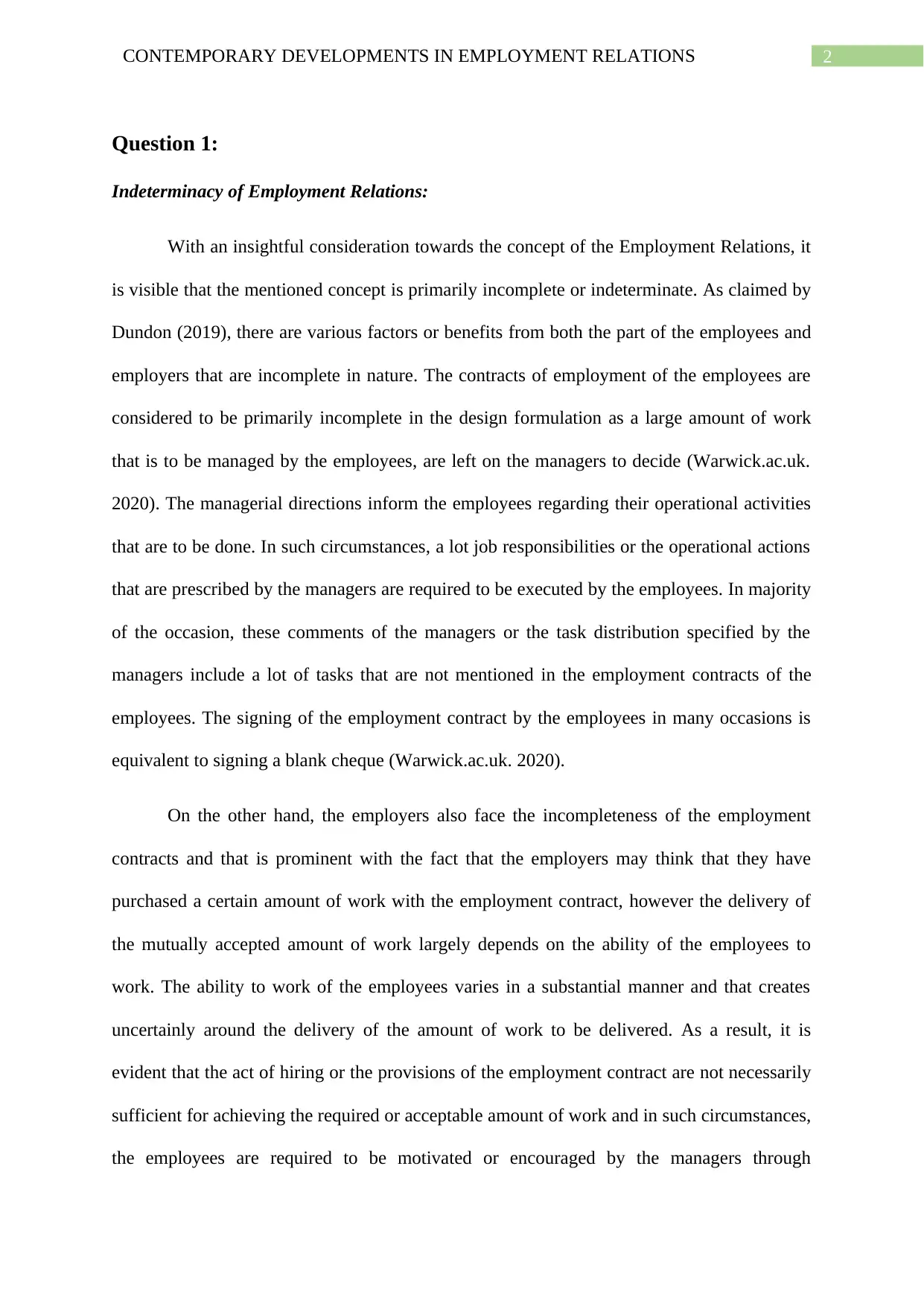
2CONTEMPORARY DEVELOPMENTS IN EMPLOYMENT RELATIONS
Question 1:
Indeterminacy of Employment Relations:
With an insightful consideration towards the concept of the Employment Relations, it
is visible that the mentioned concept is primarily incomplete or indeterminate. As claimed by
Dundon (2019), there are various factors or benefits from both the part of the employees and
employers that are incomplete in nature. The contracts of employment of the employees are
considered to be primarily incomplete in the design formulation as a large amount of work
that is to be managed by the employees, are left on the managers to decide (Warwick.ac.uk.
2020). The managerial directions inform the employees regarding their operational activities
that are to be done. In such circumstances, a lot job responsibilities or the operational actions
that are prescribed by the managers are required to be executed by the employees. In majority
of the occasion, these comments of the managers or the task distribution specified by the
managers include a lot of tasks that are not mentioned in the employment contracts of the
employees. The signing of the employment contract by the employees in many occasions is
equivalent to signing a blank cheque (Warwick.ac.uk. 2020).
On the other hand, the employers also face the incompleteness of the employment
contracts and that is prominent with the fact that the employers may think that they have
purchased a certain amount of work with the employment contract, however the delivery of
the mutually accepted amount of work largely depends on the ability of the employees to
work. The ability to work of the employees varies in a substantial manner and that creates
uncertainly around the delivery of the amount of work to be delivered. As a result, it is
evident that the act of hiring or the provisions of the employment contract are not necessarily
sufficient for achieving the required or acceptable amount of work and in such circumstances,
the employees are required to be motivated or encouraged by the managers through
Question 1:
Indeterminacy of Employment Relations:
With an insightful consideration towards the concept of the Employment Relations, it
is visible that the mentioned concept is primarily incomplete or indeterminate. As claimed by
Dundon (2019), there are various factors or benefits from both the part of the employees and
employers that are incomplete in nature. The contracts of employment of the employees are
considered to be primarily incomplete in the design formulation as a large amount of work
that is to be managed by the employees, are left on the managers to decide (Warwick.ac.uk.
2020). The managerial directions inform the employees regarding their operational activities
that are to be done. In such circumstances, a lot job responsibilities or the operational actions
that are prescribed by the managers are required to be executed by the employees. In majority
of the occasion, these comments of the managers or the task distribution specified by the
managers include a lot of tasks that are not mentioned in the employment contracts of the
employees. The signing of the employment contract by the employees in many occasions is
equivalent to signing a blank cheque (Warwick.ac.uk. 2020).
On the other hand, the employers also face the incompleteness of the employment
contracts and that is prominent with the fact that the employers may think that they have
purchased a certain amount of work with the employment contract, however the delivery of
the mutually accepted amount of work largely depends on the ability of the employees to
work. The ability to work of the employees varies in a substantial manner and that creates
uncertainly around the delivery of the amount of work to be delivered. As a result, it is
evident that the act of hiring or the provisions of the employment contract are not necessarily
sufficient for achieving the required or acceptable amount of work and in such circumstances,
the employees are required to be motivated or encouraged by the managers through
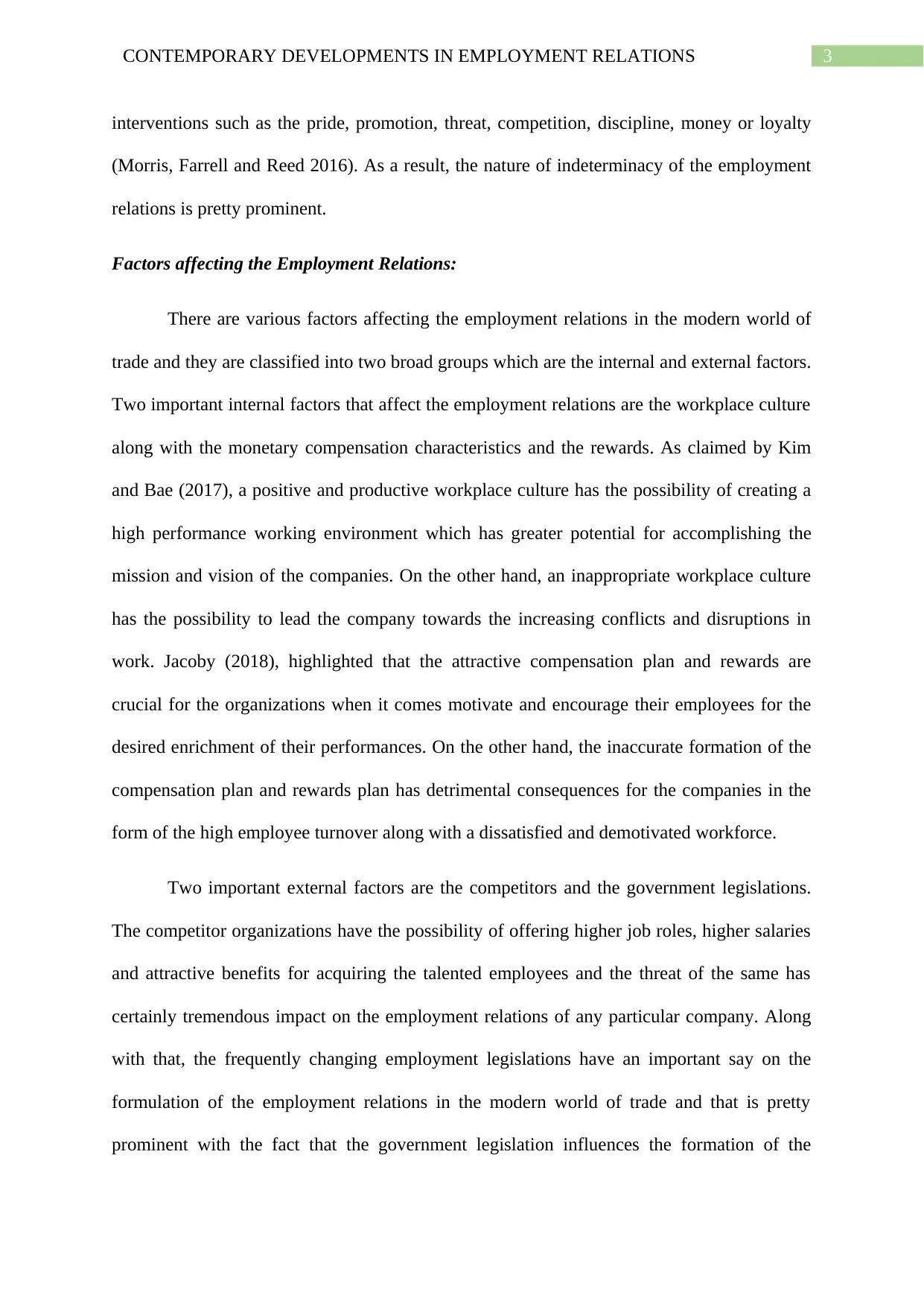
3CONTEMPORARY DEVELOPMENTS IN EMPLOYMENT RELATIONS
interventions such as the pride, promotion, threat, competition, discipline, money or loyalty
(Morris, Farrell and Reed 2016). As a result, the nature of indeterminacy of the employment
relations is pretty prominent.
Factors affecting the Employment Relations:
There are various factors affecting the employment relations in the modern world of
trade and they are classified into two broad groups which are the internal and external factors.
Two important internal factors that affect the employment relations are the workplace culture
along with the monetary compensation characteristics and the rewards. As claimed by Kim
and Bae (2017), a positive and productive workplace culture has the possibility of creating a
high performance working environment which has greater potential for accomplishing the
mission and vision of the companies. On the other hand, an inappropriate workplace culture
has the possibility to lead the company towards the increasing conflicts and disruptions in
work. Jacoby (2018), highlighted that the attractive compensation plan and rewards are
crucial for the organizations when it comes motivate and encourage their employees for the
desired enrichment of their performances. On the other hand, the inaccurate formation of the
compensation plan and rewards plan has detrimental consequences for the companies in the
form of the high employee turnover along with a dissatisfied and demotivated workforce.
Two important external factors are the competitors and the government legislations.
The competitor organizations have the possibility of offering higher job roles, higher salaries
and attractive benefits for acquiring the talented employees and the threat of the same has
certainly tremendous impact on the employment relations of any particular company. Along
with that, the frequently changing employment legislations have an important say on the
formulation of the employment relations in the modern world of trade and that is pretty
prominent with the fact that the government legislation influences the formation of the
interventions such as the pride, promotion, threat, competition, discipline, money or loyalty
(Morris, Farrell and Reed 2016). As a result, the nature of indeterminacy of the employment
relations is pretty prominent.
Factors affecting the Employment Relations:
There are various factors affecting the employment relations in the modern world of
trade and they are classified into two broad groups which are the internal and external factors.
Two important internal factors that affect the employment relations are the workplace culture
along with the monetary compensation characteristics and the rewards. As claimed by Kim
and Bae (2017), a positive and productive workplace culture has the possibility of creating a
high performance working environment which has greater potential for accomplishing the
mission and vision of the companies. On the other hand, an inappropriate workplace culture
has the possibility to lead the company towards the increasing conflicts and disruptions in
work. Jacoby (2018), highlighted that the attractive compensation plan and rewards are
crucial for the organizations when it comes motivate and encourage their employees for the
desired enrichment of their performances. On the other hand, the inaccurate formation of the
compensation plan and rewards plan has detrimental consequences for the companies in the
form of the high employee turnover along with a dissatisfied and demotivated workforce.
Two important external factors are the competitors and the government legislations.
The competitor organizations have the possibility of offering higher job roles, higher salaries
and attractive benefits for acquiring the talented employees and the threat of the same has
certainly tremendous impact on the employment relations of any particular company. Along
with that, the frequently changing employment legislations have an important say on the
formulation of the employment relations in the modern world of trade and that is pretty
prominent with the fact that the government legislation influences the formation of the
Paraphrase This Document
Need a fresh take? Get an instant paraphrase of this document with our AI Paraphraser

4CONTEMPORARY DEVELOPMENTS IN EMPLOYMENT RELATIONS
different aspects of the employment relations such as the wage and work time characteristics,
rewards plan, workplace health and safety, recruitment and selection, training and
development and diversity management (Conway et al. 2016).
Difference between the Unitarism and Pluralism approaches:
With a close consideration towards the Unitarism and Pluralism approaches, Bray,
Budd and Macneil (2019), mentioned that a perspective which has the potential to emphasize
on the shared interest of all the members of an organization is known as Unitarism. On the
other hand, a perspective which acknowledges the divergent sub- groups of an organization
along with their individual set of own legitimate interests, is recognized as Pluralism (Siebert
et al. 2015). Townsend et al. (2019), highlighted that the Unitarism approach is concerned
about the shared common goals or interests and on the other hand, the Pluralism approach is
more connected with probably conflicting goals and interests. Along with that, the conflicts
are considered as dysfunctional in the Unitarism approach whereas the conflicts are primarily
acknowledgeable and largely desirable. Bray, Budd and Macneil (2019), highlighted that the
Unitarism is a paternalistic approach which largely expects higher level of loyalty from the
part of the employees. On the other hand, the Pluralism approach is not observed to be
associated with any sort of paternalistic approach and does not portray any tendency of
expecting loyalty from the part of the employees.
Question 2:
Features of the Employment Contract:
With a close look at the United Kingdom and European Union Employment
Legislations, it is visible that some of the important features of the employment contract are
the information regarding the parties involved in the contract, job information, information
regarding the compensation and benefits, employee classification, information on the
different aspects of the employment relations such as the wage and work time characteristics,
rewards plan, workplace health and safety, recruitment and selection, training and
development and diversity management (Conway et al. 2016).
Difference between the Unitarism and Pluralism approaches:
With a close consideration towards the Unitarism and Pluralism approaches, Bray,
Budd and Macneil (2019), mentioned that a perspective which has the potential to emphasize
on the shared interest of all the members of an organization is known as Unitarism. On the
other hand, a perspective which acknowledges the divergent sub- groups of an organization
along with their individual set of own legitimate interests, is recognized as Pluralism (Siebert
et al. 2015). Townsend et al. (2019), highlighted that the Unitarism approach is concerned
about the shared common goals or interests and on the other hand, the Pluralism approach is
more connected with probably conflicting goals and interests. Along with that, the conflicts
are considered as dysfunctional in the Unitarism approach whereas the conflicts are primarily
acknowledgeable and largely desirable. Bray, Budd and Macneil (2019), highlighted that the
Unitarism is a paternalistic approach which largely expects higher level of loyalty from the
part of the employees. On the other hand, the Pluralism approach is not observed to be
associated with any sort of paternalistic approach and does not portray any tendency of
expecting loyalty from the part of the employees.
Question 2:
Features of the Employment Contract:
With a close look at the United Kingdom and European Union Employment
Legislations, it is visible that some of the important features of the employment contract are
the information regarding the parties involved in the contract, job information, information
regarding the compensation and benefits, employee classification, information on the

5CONTEMPORARY DEVELOPMENTS IN EMPLOYMENT RELATIONS
confidentiality clauses, information regarding the employment schedule and period, non-
compete clauses, technology privacy policies and information regarding the termination of
the employees (Ceanîşeva 2015). The provision of the parties involved clarifies the
information regarding the employees and employers. On the other hand, the job information
specifies the basic information regarding the job such as the position, supervisors,
departments and the criteria of performance evaluation. Along with that, the provision of the
compensation and rewards clarifies the information regarding the value added benefits and
the compensation that the employer is expected to deliver to the employee against his or her
efforts for the company. The provision of the employee classification is pretty significant in
stating the type of employment such as whether it is full time or part time employment
(Lammerts et al. 2016).
The employment schedule or period is an important feature of the employment
contract as it informs regarding the tenancy of employment contract between an employer
and the employee. The non- compete clauses are regarded as the safety measures from the
part of the employers as it effectively ensures that the employee contracted with an particular
employer will not be involved in any sort of work with their competitor organizations within
the time period of contract (Marx, Singh and Fleming 2015). The confidentiality clauses are
of great significance for the modern employers as it puts on strong obligation to the
employees for not disclosing any sort of confidential and sensitive information such as the
trade related secrets and the customer information to any third party organizations or
competitors (Yekini and Anjorin 2016). Apart from this, the technology is an important
aspect of today’s world of business and that is pretty prominent with substantial utilization of
the same in each and every stages of the business. Having said that, it is important for the
organizations to ensure that the privacy associated with the usage of the technology is
maintained with higher degree of success. As a result, role of the technology privacy policy is
confidentiality clauses, information regarding the employment schedule and period, non-
compete clauses, technology privacy policies and information regarding the termination of
the employees (Ceanîşeva 2015). The provision of the parties involved clarifies the
information regarding the employees and employers. On the other hand, the job information
specifies the basic information regarding the job such as the position, supervisors,
departments and the criteria of performance evaluation. Along with that, the provision of the
compensation and rewards clarifies the information regarding the value added benefits and
the compensation that the employer is expected to deliver to the employee against his or her
efforts for the company. The provision of the employee classification is pretty significant in
stating the type of employment such as whether it is full time or part time employment
(Lammerts et al. 2016).
The employment schedule or period is an important feature of the employment
contract as it informs regarding the tenancy of employment contract between an employer
and the employee. The non- compete clauses are regarded as the safety measures from the
part of the employers as it effectively ensures that the employee contracted with an particular
employer will not be involved in any sort of work with their competitor organizations within
the time period of contract (Marx, Singh and Fleming 2015). The confidentiality clauses are
of great significance for the modern employers as it puts on strong obligation to the
employees for not disclosing any sort of confidential and sensitive information such as the
trade related secrets and the customer information to any third party organizations or
competitors (Yekini and Anjorin 2016). Apart from this, the technology is an important
aspect of today’s world of business and that is pretty prominent with substantial utilization of
the same in each and every stages of the business. Having said that, it is important for the
organizations to ensure that the privacy associated with the usage of the technology is
maintained with higher degree of success. As a result, role of the technology privacy policy is
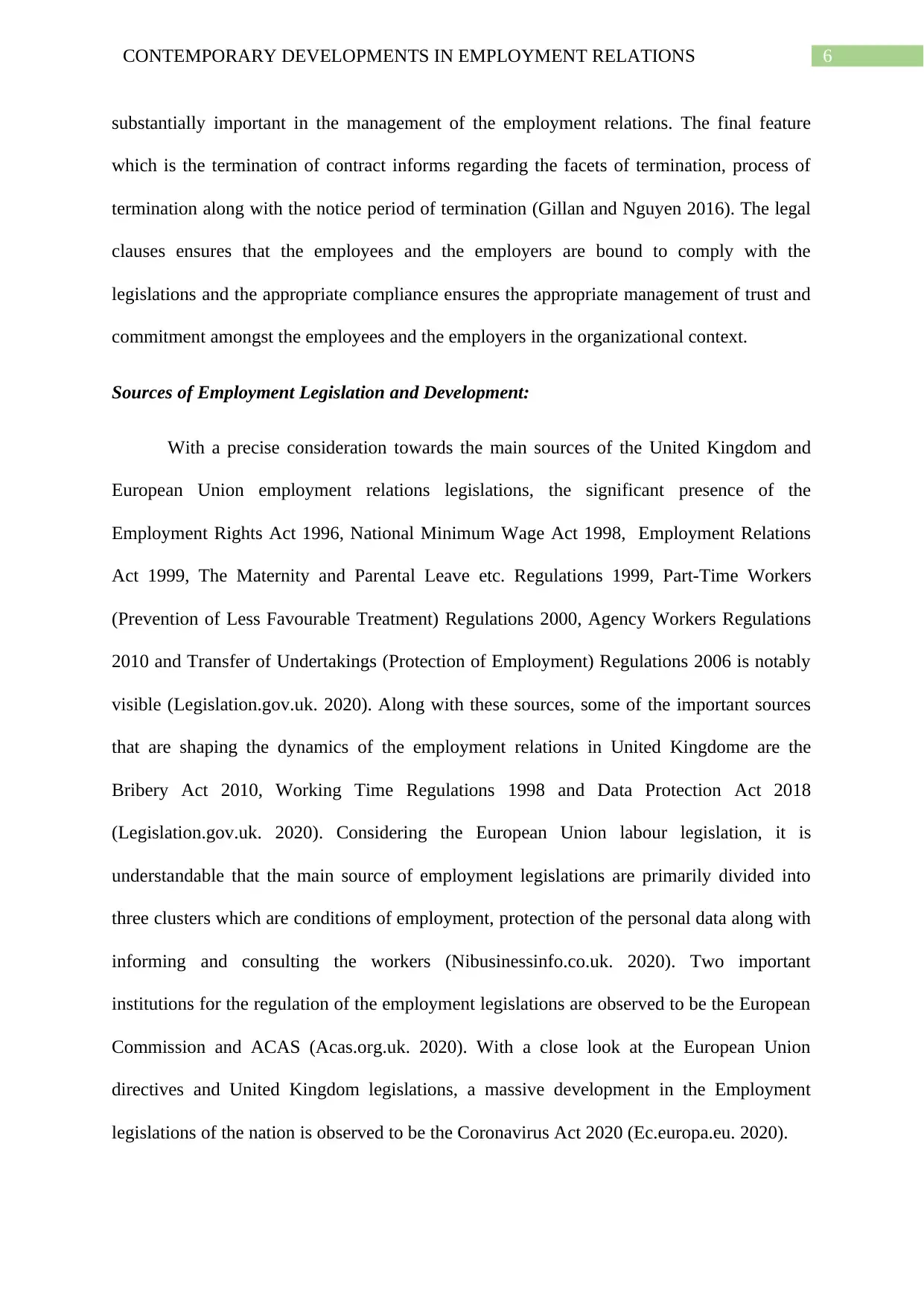
6CONTEMPORARY DEVELOPMENTS IN EMPLOYMENT RELATIONS
substantially important in the management of the employment relations. The final feature
which is the termination of contract informs regarding the facets of termination, process of
termination along with the notice period of termination (Gillan and Nguyen 2016). The legal
clauses ensures that the employees and the employers are bound to comply with the
legislations and the appropriate compliance ensures the appropriate management of trust and
commitment amongst the employees and the employers in the organizational context.
Sources of Employment Legislation and Development:
With a precise consideration towards the main sources of the United Kingdom and
European Union employment relations legislations, the significant presence of the
Employment Rights Act 1996, National Minimum Wage Act 1998, Employment Relations
Act 1999, The Maternity and Parental Leave etc. Regulations 1999, Part-Time Workers
(Prevention of Less Favourable Treatment) Regulations 2000, Agency Workers Regulations
2010 and Transfer of Undertakings (Protection of Employment) Regulations 2006 is notably
visible (Legislation.gov.uk. 2020). Along with these sources, some of the important sources
that are shaping the dynamics of the employment relations in United Kingdome are the
Bribery Act 2010, Working Time Regulations 1998 and Data Protection Act 2018
(Legislation.gov.uk. 2020). Considering the European Union labour legislation, it is
understandable that the main source of employment legislations are primarily divided into
three clusters which are conditions of employment, protection of the personal data along with
informing and consulting the workers (Nibusinessinfo.co.uk. 2020). Two important
institutions for the regulation of the employment legislations are observed to be the European
Commission and ACAS (Acas.org.uk. 2020). With a close look at the European Union
directives and United Kingdom legislations, a massive development in the Employment
legislations of the nation is observed to be the Coronavirus Act 2020 (Ec.europa.eu. 2020).
substantially important in the management of the employment relations. The final feature
which is the termination of contract informs regarding the facets of termination, process of
termination along with the notice period of termination (Gillan and Nguyen 2016). The legal
clauses ensures that the employees and the employers are bound to comply with the
legislations and the appropriate compliance ensures the appropriate management of trust and
commitment amongst the employees and the employers in the organizational context.
Sources of Employment Legislation and Development:
With a precise consideration towards the main sources of the United Kingdom and
European Union employment relations legislations, the significant presence of the
Employment Rights Act 1996, National Minimum Wage Act 1998, Employment Relations
Act 1999, The Maternity and Parental Leave etc. Regulations 1999, Part-Time Workers
(Prevention of Less Favourable Treatment) Regulations 2000, Agency Workers Regulations
2010 and Transfer of Undertakings (Protection of Employment) Regulations 2006 is notably
visible (Legislation.gov.uk. 2020). Along with these sources, some of the important sources
that are shaping the dynamics of the employment relations in United Kingdome are the
Bribery Act 2010, Working Time Regulations 1998 and Data Protection Act 2018
(Legislation.gov.uk. 2020). Considering the European Union labour legislation, it is
understandable that the main source of employment legislations are primarily divided into
three clusters which are conditions of employment, protection of the personal data along with
informing and consulting the workers (Nibusinessinfo.co.uk. 2020). Two important
institutions for the regulation of the employment legislations are observed to be the European
Commission and ACAS (Acas.org.uk. 2020). With a close look at the European Union
directives and United Kingdom legislations, a massive development in the Employment
legislations of the nation is observed to be the Coronavirus Act 2020 (Ec.europa.eu. 2020).
Secure Best Marks with AI Grader
Need help grading? Try our AI Grader for instant feedback on your assignments.
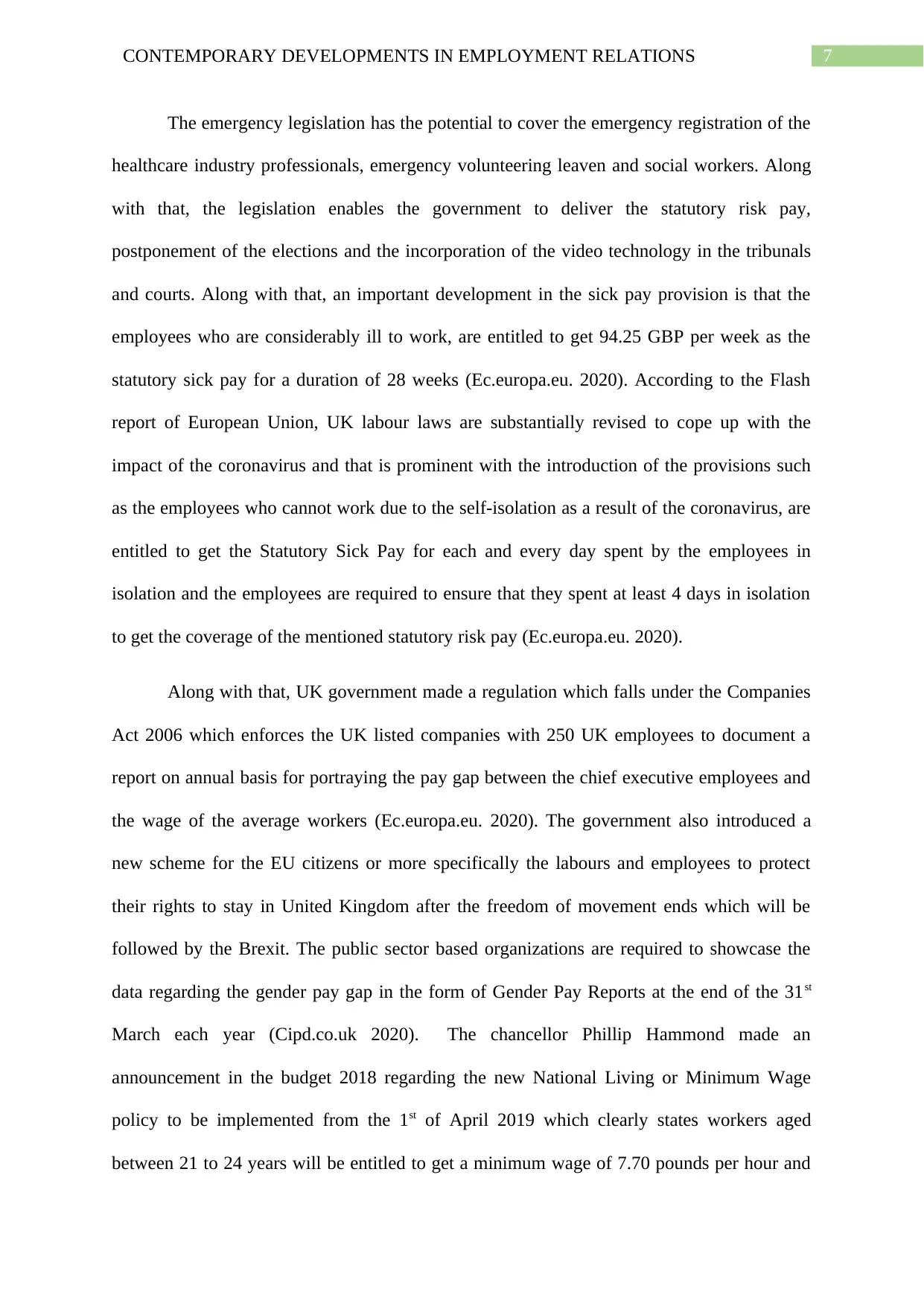
7CONTEMPORARY DEVELOPMENTS IN EMPLOYMENT RELATIONS
The emergency legislation has the potential to cover the emergency registration of the
healthcare industry professionals, emergency volunteering leaven and social workers. Along
with that, the legislation enables the government to deliver the statutory risk pay,
postponement of the elections and the incorporation of the video technology in the tribunals
and courts. Along with that, an important development in the sick pay provision is that the
employees who are considerably ill to work, are entitled to get 94.25 GBP per week as the
statutory sick pay for a duration of 28 weeks (Ec.europa.eu. 2020). According to the Flash
report of European Union, UK labour laws are substantially revised to cope up with the
impact of the coronavirus and that is prominent with the introduction of the provisions such
as the employees who cannot work due to the self-isolation as a result of the coronavirus, are
entitled to get the Statutory Sick Pay for each and every day spent by the employees in
isolation and the employees are required to ensure that they spent at least 4 days in isolation
to get the coverage of the mentioned statutory risk pay (Ec.europa.eu. 2020).
Along with that, UK government made a regulation which falls under the Companies
Act 2006 which enforces the UK listed companies with 250 UK employees to document a
report on annual basis for portraying the pay gap between the chief executive employees and
the wage of the average workers (Ec.europa.eu. 2020). The government also introduced a
new scheme for the EU citizens or more specifically the labours and employees to protect
their rights to stay in United Kingdom after the freedom of movement ends which will be
followed by the Brexit. The public sector based organizations are required to showcase the
data regarding the gender pay gap in the form of Gender Pay Reports at the end of the 31st
March each year (Cipd.co.uk 2020). The chancellor Phillip Hammond made an
announcement in the budget 2018 regarding the new National Living or Minimum Wage
policy to be implemented from the 1st of April 2019 which clearly states workers aged
between 21 to 24 years will be entitled to get a minimum wage of 7.70 pounds per hour and
The emergency legislation has the potential to cover the emergency registration of the
healthcare industry professionals, emergency volunteering leaven and social workers. Along
with that, the legislation enables the government to deliver the statutory risk pay,
postponement of the elections and the incorporation of the video technology in the tribunals
and courts. Along with that, an important development in the sick pay provision is that the
employees who are considerably ill to work, are entitled to get 94.25 GBP per week as the
statutory sick pay for a duration of 28 weeks (Ec.europa.eu. 2020). According to the Flash
report of European Union, UK labour laws are substantially revised to cope up with the
impact of the coronavirus and that is prominent with the introduction of the provisions such
as the employees who cannot work due to the self-isolation as a result of the coronavirus, are
entitled to get the Statutory Sick Pay for each and every day spent by the employees in
isolation and the employees are required to ensure that they spent at least 4 days in isolation
to get the coverage of the mentioned statutory risk pay (Ec.europa.eu. 2020).
Along with that, UK government made a regulation which falls under the Companies
Act 2006 which enforces the UK listed companies with 250 UK employees to document a
report on annual basis for portraying the pay gap between the chief executive employees and
the wage of the average workers (Ec.europa.eu. 2020). The government also introduced a
new scheme for the EU citizens or more specifically the labours and employees to protect
their rights to stay in United Kingdom after the freedom of movement ends which will be
followed by the Brexit. The public sector based organizations are required to showcase the
data regarding the gender pay gap in the form of Gender Pay Reports at the end of the 31st
March each year (Cipd.co.uk 2020). The chancellor Phillip Hammond made an
announcement in the budget 2018 regarding the new National Living or Minimum Wage
policy to be implemented from the 1st of April 2019 which clearly states workers aged
between 21 to 24 years will be entitled to get a minimum wage of 7.70 pounds per hour and

8CONTEMPORARY DEVELOPMENTS IN EMPLOYMENT RELATIONS
at the same time, the employees belonging to the age range of 25 years and above, will be
eligible for a minimum wage of 8.21 pounds per hour (Cipd.co.uk 2020).
(Information Courtesy: Cipd.co.uk 2020)
Question 3:
Advise on purpose and scope of statutory trade union recognition:
The industrial actions have the possibility to lead to the complicated issues which
require legal interventions. The current employment legislations of the United Kingdom is
seen to be substantially focused towards the statutory recognition of the trade unions. The
scope of the statutory recognition of the trade unions is pretty prominent in the United
Kingdom legislation. The advice is such that a trade union gets recognized in United
Kingdom only in case it is independent and is recognized by one or multiple employers and
associated employers for collective bargaining. The trade union recognition can be a
voluntary agreement between multiple parties and at the same time, an application can be
made for making the recognition as statutory recognition (GOV.UK. 2020). At the same time,
the provision of the enforced statutory recognition is also there in the employment legislation
of the nation where an independent or multiple trade unions acting together can file a request
for the recognition. In case any employer in United Kingdom, along with an associated
employer is employing less than 21 workers on the day of recognition request, the trade union
recognition request will be considered as invalid (GOV.UK. 2020). As a result, it is
at the same time, the employees belonging to the age range of 25 years and above, will be
eligible for a minimum wage of 8.21 pounds per hour (Cipd.co.uk 2020).
(Information Courtesy: Cipd.co.uk 2020)
Question 3:
Advise on purpose and scope of statutory trade union recognition:
The industrial actions have the possibility to lead to the complicated issues which
require legal interventions. The current employment legislations of the United Kingdom is
seen to be substantially focused towards the statutory recognition of the trade unions. The
scope of the statutory recognition of the trade unions is pretty prominent in the United
Kingdom legislation. The advice is such that a trade union gets recognized in United
Kingdom only in case it is independent and is recognized by one or multiple employers and
associated employers for collective bargaining. The trade union recognition can be a
voluntary agreement between multiple parties and at the same time, an application can be
made for making the recognition as statutory recognition (GOV.UK. 2020). At the same time,
the provision of the enforced statutory recognition is also there in the employment legislation
of the nation where an independent or multiple trade unions acting together can file a request
for the recognition. In case any employer in United Kingdom, along with an associated
employer is employing less than 21 workers on the day of recognition request, the trade union
recognition request will be considered as invalid (GOV.UK. 2020). As a result, it is
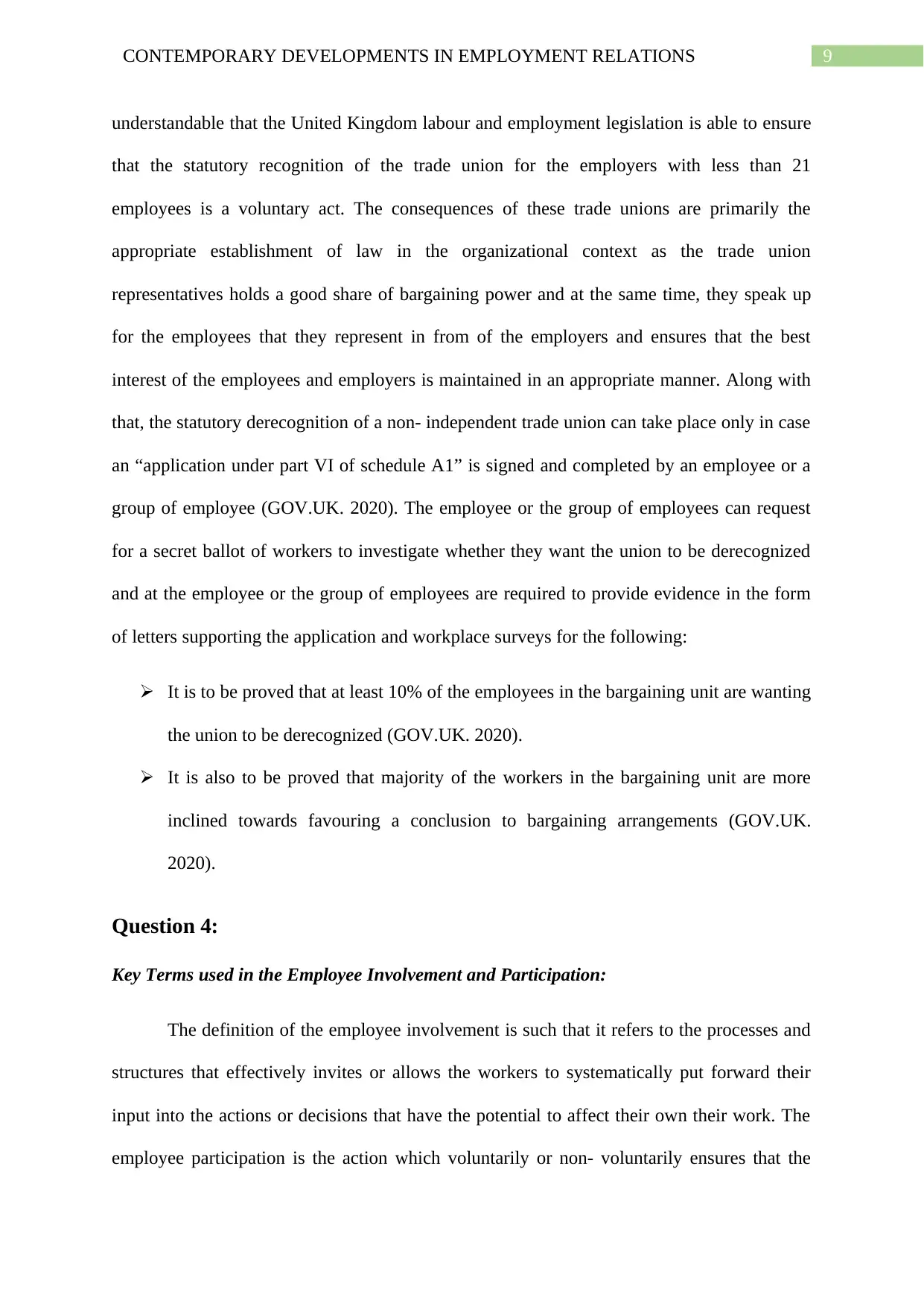
9CONTEMPORARY DEVELOPMENTS IN EMPLOYMENT RELATIONS
understandable that the United Kingdom labour and employment legislation is able to ensure
that the statutory recognition of the trade union for the employers with less than 21
employees is a voluntary act. The consequences of these trade unions are primarily the
appropriate establishment of law in the organizational context as the trade union
representatives holds a good share of bargaining power and at the same time, they speak up
for the employees that they represent in from of the employers and ensures that the best
interest of the employees and employers is maintained in an appropriate manner. Along with
that, the statutory derecognition of a non- independent trade union can take place only in case
an “application under part VI of schedule A1” is signed and completed by an employee or a
group of employee (GOV.UK. 2020). The employee or the group of employees can request
for a secret ballot of workers to investigate whether they want the union to be derecognized
and at the employee or the group of employees are required to provide evidence in the form
of letters supporting the application and workplace surveys for the following:
It is to be proved that at least 10% of the employees in the bargaining unit are wanting
the union to be derecognized (GOV.UK. 2020).
It is also to be proved that majority of the workers in the bargaining unit are more
inclined towards favouring a conclusion to bargaining arrangements (GOV.UK.
2020).
Question 4:
Key Terms used in the Employee Involvement and Participation:
The definition of the employee involvement is such that it refers to the processes and
structures that effectively invites or allows the workers to systematically put forward their
input into the actions or decisions that have the potential to affect their own their work. The
employee participation is the action which voluntarily or non- voluntarily ensures that the
understandable that the United Kingdom labour and employment legislation is able to ensure
that the statutory recognition of the trade union for the employers with less than 21
employees is a voluntary act. The consequences of these trade unions are primarily the
appropriate establishment of law in the organizational context as the trade union
representatives holds a good share of bargaining power and at the same time, they speak up
for the employees that they represent in from of the employers and ensures that the best
interest of the employees and employers is maintained in an appropriate manner. Along with
that, the statutory derecognition of a non- independent trade union can take place only in case
an “application under part VI of schedule A1” is signed and completed by an employee or a
group of employee (GOV.UK. 2020). The employee or the group of employees can request
for a secret ballot of workers to investigate whether they want the union to be derecognized
and at the employee or the group of employees are required to provide evidence in the form
of letters supporting the application and workplace surveys for the following:
It is to be proved that at least 10% of the employees in the bargaining unit are wanting
the union to be derecognized (GOV.UK. 2020).
It is also to be proved that majority of the workers in the bargaining unit are more
inclined towards favouring a conclusion to bargaining arrangements (GOV.UK.
2020).
Question 4:
Key Terms used in the Employee Involvement and Participation:
The definition of the employee involvement is such that it refers to the processes and
structures that effectively invites or allows the workers to systematically put forward their
input into the actions or decisions that have the potential to affect their own their work. The
employee participation is the action which voluntarily or non- voluntarily ensures that the
Paraphrase This Document
Need a fresh take? Get an instant paraphrase of this document with our AI Paraphraser
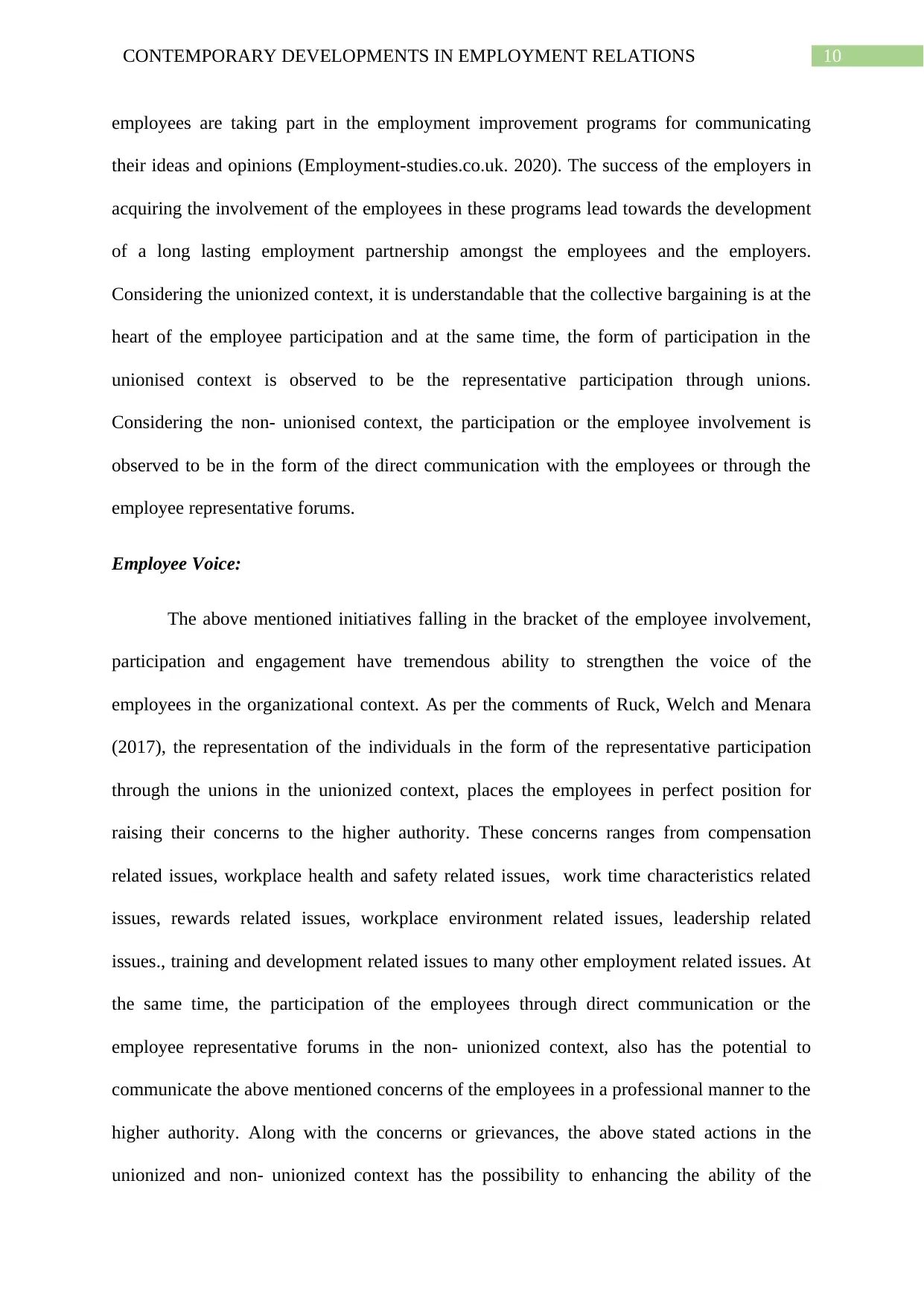
10CONTEMPORARY DEVELOPMENTS IN EMPLOYMENT RELATIONS
employees are taking part in the employment improvement programs for communicating
their ideas and opinions (Employment-studies.co.uk. 2020). The success of the employers in
acquiring the involvement of the employees in these programs lead towards the development
of a long lasting employment partnership amongst the employees and the employers.
Considering the unionized context, it is understandable that the collective bargaining is at the
heart of the employee participation and at the same time, the form of participation in the
unionised context is observed to be the representative participation through unions.
Considering the non- unionised context, the participation or the employee involvement is
observed to be in the form of the direct communication with the employees or through the
employee representative forums.
Employee Voice:
The above mentioned initiatives falling in the bracket of the employee involvement,
participation and engagement have tremendous ability to strengthen the voice of the
employees in the organizational context. As per the comments of Ruck, Welch and Menara
(2017), the representation of the individuals in the form of the representative participation
through the unions in the unionized context, places the employees in perfect position for
raising their concerns to the higher authority. These concerns ranges from compensation
related issues, workplace health and safety related issues, work time characteristics related
issues, rewards related issues, workplace environment related issues, leadership related
issues., training and development related issues to many other employment related issues. At
the same time, the participation of the employees through direct communication or the
employee representative forums in the non- unionized context, also has the potential to
communicate the above mentioned concerns of the employees in a professional manner to the
higher authority. Along with the concerns or grievances, the above stated actions in the
unionized and non- unionized context has the possibility to enhancing the ability of the
employees are taking part in the employment improvement programs for communicating
their ideas and opinions (Employment-studies.co.uk. 2020). The success of the employers in
acquiring the involvement of the employees in these programs lead towards the development
of a long lasting employment partnership amongst the employees and the employers.
Considering the unionized context, it is understandable that the collective bargaining is at the
heart of the employee participation and at the same time, the form of participation in the
unionised context is observed to be the representative participation through unions.
Considering the non- unionised context, the participation or the employee involvement is
observed to be in the form of the direct communication with the employees or through the
employee representative forums.
Employee Voice:
The above mentioned initiatives falling in the bracket of the employee involvement,
participation and engagement have tremendous ability to strengthen the voice of the
employees in the organizational context. As per the comments of Ruck, Welch and Menara
(2017), the representation of the individuals in the form of the representative participation
through the unions in the unionized context, places the employees in perfect position for
raising their concerns to the higher authority. These concerns ranges from compensation
related issues, workplace health and safety related issues, work time characteristics related
issues, rewards related issues, workplace environment related issues, leadership related
issues., training and development related issues to many other employment related issues. At
the same time, the participation of the employees through direct communication or the
employee representative forums in the non- unionized context, also has the potential to
communicate the above mentioned concerns of the employees in a professional manner to the
higher authority. Along with the concerns or grievances, the above stated actions in the
unionized and non- unionized context has the possibility to enhancing the ability of the
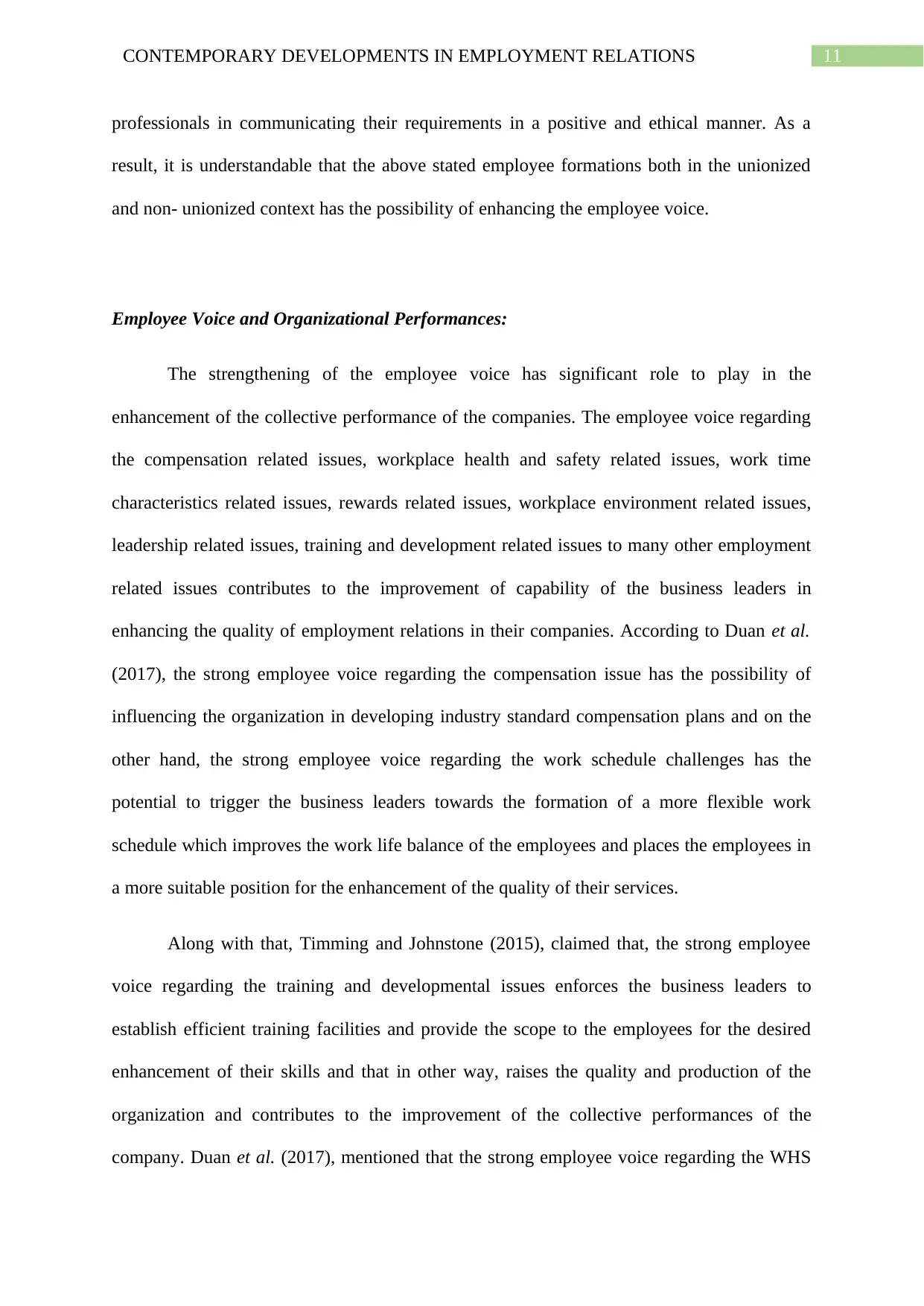
11CONTEMPORARY DEVELOPMENTS IN EMPLOYMENT RELATIONS
professionals in communicating their requirements in a positive and ethical manner. As a
result, it is understandable that the above stated employee formations both in the unionized
and non- unionized context has the possibility of enhancing the employee voice.
Employee Voice and Organizational Performances:
The strengthening of the employee voice has significant role to play in the
enhancement of the collective performance of the companies. The employee voice regarding
the compensation related issues, workplace health and safety related issues, work time
characteristics related issues, rewards related issues, workplace environment related issues,
leadership related issues, training and development related issues to many other employment
related issues contributes to the improvement of capability of the business leaders in
enhancing the quality of employment relations in their companies. According to Duan et al.
(2017), the strong employee voice regarding the compensation issue has the possibility of
influencing the organization in developing industry standard compensation plans and on the
other hand, the strong employee voice regarding the work schedule challenges has the
potential to trigger the business leaders towards the formation of a more flexible work
schedule which improves the work life balance of the employees and places the employees in
a more suitable position for the enhancement of the quality of their services.
Along with that, Timming and Johnstone (2015), claimed that, the strong employee
voice regarding the training and developmental issues enforces the business leaders to
establish efficient training facilities and provide the scope to the employees for the desired
enhancement of their skills and that in other way, raises the quality and production of the
organization and contributes to the improvement of the collective performances of the
company. Duan et al. (2017), mentioned that the strong employee voice regarding the WHS
professionals in communicating their requirements in a positive and ethical manner. As a
result, it is understandable that the above stated employee formations both in the unionized
and non- unionized context has the possibility of enhancing the employee voice.
Employee Voice and Organizational Performances:
The strengthening of the employee voice has significant role to play in the
enhancement of the collective performance of the companies. The employee voice regarding
the compensation related issues, workplace health and safety related issues, work time
characteristics related issues, rewards related issues, workplace environment related issues,
leadership related issues, training and development related issues to many other employment
related issues contributes to the improvement of capability of the business leaders in
enhancing the quality of employment relations in their companies. According to Duan et al.
(2017), the strong employee voice regarding the compensation issue has the possibility of
influencing the organization in developing industry standard compensation plans and on the
other hand, the strong employee voice regarding the work schedule challenges has the
potential to trigger the business leaders towards the formation of a more flexible work
schedule which improves the work life balance of the employees and places the employees in
a more suitable position for the enhancement of the quality of their services.
Along with that, Timming and Johnstone (2015), claimed that, the strong employee
voice regarding the training and developmental issues enforces the business leaders to
establish efficient training facilities and provide the scope to the employees for the desired
enhancement of their skills and that in other way, raises the quality and production of the
organization and contributes to the improvement of the collective performances of the
company. Duan et al. (2017), mentioned that the strong employee voice regarding the WHS

12CONTEMPORARY DEVELOPMENTS IN EMPLOYMENT RELATIONS
issues also contributes to the rise of the WHS infrastructural strength and that ensures that the
company be able to motivate their employees for further improvement in their performance
through ensuring that they are not exposed to any sort of workplace injuries or threats. Most
importantly the employee voice also has the possibility of improving the position of the
company in managing their business actions in an ethical manner. Burris, Rockmann and
Kimmons (2017), highlighted that the whistle blower protection and the provision for the
whistle blowing enables the employees to contribute to the maintenance of corporate ethics
inside their organizations and at the same time, it places the employers in a comfortable
position from facing the reputational damage and financial penalization as a result of
unethical business actions. Hence, it is understandable that the strengthening of the employee
voice has the potential to contribute to the improvement of the overall performances of the
companies.
Question 5:
There are several instances or sources of differences and misbehaviours between the
modern employees and the employers and that is regarded as one of the substantial challenges
for the companies in developing high performing teams and enhancing the collective
excellence of the team performances. Personality clashes is one of the fundamental form of
challenge that takes place between the employees and ruins the good bond which is much
required for the enhancement of the collective team performances. Fowler (2015), mentioned
that the personality clash can be based on different factors such as the differences in the
decision making, apathy in working together and failing to find consensus regarding the
management of the operational activities. Other than this, Ackroyd and Thompson (2016),
mentioned that there misbehaviours amongst the employees also take place due to the
grievances developed amongst the individuals. These grievances can be based on the
inappropriate recognition of the performances of the employees, discrimination faced by the
issues also contributes to the rise of the WHS infrastructural strength and that ensures that the
company be able to motivate their employees for further improvement in their performance
through ensuring that they are not exposed to any sort of workplace injuries or threats. Most
importantly the employee voice also has the possibility of improving the position of the
company in managing their business actions in an ethical manner. Burris, Rockmann and
Kimmons (2017), highlighted that the whistle blower protection and the provision for the
whistle blowing enables the employees to contribute to the maintenance of corporate ethics
inside their organizations and at the same time, it places the employers in a comfortable
position from facing the reputational damage and financial penalization as a result of
unethical business actions. Hence, it is understandable that the strengthening of the employee
voice has the potential to contribute to the improvement of the overall performances of the
companies.
Question 5:
There are several instances or sources of differences and misbehaviours between the
modern employees and the employers and that is regarded as one of the substantial challenges
for the companies in developing high performing teams and enhancing the collective
excellence of the team performances. Personality clashes is one of the fundamental form of
challenge that takes place between the employees and ruins the good bond which is much
required for the enhancement of the collective team performances. Fowler (2015), mentioned
that the personality clash can be based on different factors such as the differences in the
decision making, apathy in working together and failing to find consensus regarding the
management of the operational activities. Other than this, Ackroyd and Thompson (2016),
mentioned that there misbehaviours amongst the employees also take place due to the
grievances developed amongst the individuals. These grievances can be based on the
inappropriate recognition of the performances of the employees, discrimination faced by the
Secure Best Marks with AI Grader
Need help grading? Try our AI Grader for instant feedback on your assignments.

13CONTEMPORARY DEVELOPMENTS IN EMPLOYMENT RELATIONS
employees on the basis of their cultural values, social beliefs, gender, language and race.
Along with that, it is evident that there are several companies that are facing the detrimental
impact of the management issues between the employees and the line managers. The reasons
or the factors for these sort of conflicts or misbehaviours are observed to range from the
issues related to the workplace violence or cases of bullying, inappropriate mails, cases of
dishonesty, substance abuse to the minor issues such as the excessive usage of internet
(Fowler 2015). In addition to this, the good relationship between the line managers and the
employees has the possibility to go down owing to the disputes or conflicts that are present in
the modern world related to the performance and training issues.
Considering the official and unofficial industrial actions leading to the disputes and
the challenges, Fudge (2015), mentioned that the union initiated labour strikes are to be
considered as the official industrial action that leads to the conflicts or represents the official
industrial misbehaviour. Majority of the UK based organizations and the global companies
are observed to be associated with multiple recognized trade associations which raise the
voice for protecting the rights of the employees (Holgate 2015). These trade associations
fight for the appropriate wage, work time, safety, rewards, health and training management
for their employees. Having said that, the companies in many occasions, are observed to be
reluctant in considering the employee voice and in such situation, the official industrial action
in the form of the union initiated labour strikes are a major weapon for the unions and that
effectively is based on the conflicts between the employees and employers (Coderre-LaPalme
and Greer 2018). On the other hand, the unofficial industrial actions are primarily the
conflicts that the companies face from the part of the general individuals operating in their
organizations. These conflicts are primarily based on the individual grievances of the
employees developing in short time or over a course of actions.
employees on the basis of their cultural values, social beliefs, gender, language and race.
Along with that, it is evident that there are several companies that are facing the detrimental
impact of the management issues between the employees and the line managers. The reasons
or the factors for these sort of conflicts or misbehaviours are observed to range from the
issues related to the workplace violence or cases of bullying, inappropriate mails, cases of
dishonesty, substance abuse to the minor issues such as the excessive usage of internet
(Fowler 2015). In addition to this, the good relationship between the line managers and the
employees has the possibility to go down owing to the disputes or conflicts that are present in
the modern world related to the performance and training issues.
Considering the official and unofficial industrial actions leading to the disputes and
the challenges, Fudge (2015), mentioned that the union initiated labour strikes are to be
considered as the official industrial action that leads to the conflicts or represents the official
industrial misbehaviour. Majority of the UK based organizations and the global companies
are observed to be associated with multiple recognized trade associations which raise the
voice for protecting the rights of the employees (Holgate 2015). These trade associations
fight for the appropriate wage, work time, safety, rewards, health and training management
for their employees. Having said that, the companies in many occasions, are observed to be
reluctant in considering the employee voice and in such situation, the official industrial action
in the form of the union initiated labour strikes are a major weapon for the unions and that
effectively is based on the conflicts between the employees and employers (Coderre-LaPalme
and Greer 2018). On the other hand, the unofficial industrial actions are primarily the
conflicts that the companies face from the part of the general individuals operating in their
organizations. These conflicts are primarily based on the individual grievances of the
employees developing in short time or over a course of actions.

14CONTEMPORARY DEVELOPMENTS IN EMPLOYMENT RELATIONS
Some of the contemporary trends in the organizational conflicts in the United
Kingdom and European labour market are seen to be the increment in the hourly disruption of
work, single or multiple days of labour strikes, employee bans or suspensions and strike for
undetermined period of time. The hourly disruption of work is pretty prominent in the
banking industry where the employees showcase their grievances through suspending their
operations for a particular period of time. On the other hand, the labour strikes for one or
multiple days for portraying their grievances is prominent with the labour strikes took place
in Walmart (McVeigh 2020). The employers also practice the power of the employee
suspension where they suspend the employees for their misbehaviour and the final action
which is primarily union initiated is the suspension of operations from the part of the
employees for a prolonged and undetermined period of time until their conflicts with the
employers do not get resolved.
Question 6:
As claimed by Mat and Barrett (2015), the line managers are the fundamental group
of people responsible for the management of the disputes ad grievances of the employees. As
the line managers are the most important set of people for tackling the employee grievances,
it is crucial for them to inherit certain qualities such as strong interpersonal skills,
investigation skills and ability of effective communication. The coaching advice regarding
the skills will be to practice the different problem solving and investigation technique such as
the Decision making tree, Fishbone diagram and 5 Whys (Chang 2015). Along with that, the
availability of the strong listening skills and the emotional intelligence are much required for
the line managers to handle the grievances or the disputes that take place amongst the
employees. The guidance for the employees will be to maintain a focused mind set and
openness towards learning new things as that will be helpful for the line managers in
resolving the conflicts or disputes in a more professional manner.
Some of the contemporary trends in the organizational conflicts in the United
Kingdom and European labour market are seen to be the increment in the hourly disruption of
work, single or multiple days of labour strikes, employee bans or suspensions and strike for
undetermined period of time. The hourly disruption of work is pretty prominent in the
banking industry where the employees showcase their grievances through suspending their
operations for a particular period of time. On the other hand, the labour strikes for one or
multiple days for portraying their grievances is prominent with the labour strikes took place
in Walmart (McVeigh 2020). The employers also practice the power of the employee
suspension where they suspend the employees for their misbehaviour and the final action
which is primarily union initiated is the suspension of operations from the part of the
employees for a prolonged and undetermined period of time until their conflicts with the
employers do not get resolved.
Question 6:
As claimed by Mat and Barrett (2015), the line managers are the fundamental group
of people responsible for the management of the disputes ad grievances of the employees. As
the line managers are the most important set of people for tackling the employee grievances,
it is crucial for them to inherit certain qualities such as strong interpersonal skills,
investigation skills and ability of effective communication. The coaching advice regarding
the skills will be to practice the different problem solving and investigation technique such as
the Decision making tree, Fishbone diagram and 5 Whys (Chang 2015). Along with that, the
availability of the strong listening skills and the emotional intelligence are much required for
the line managers to handle the grievances or the disputes that take place amongst the
employees. The guidance for the employees will be to maintain a focused mind set and
openness towards learning new things as that will be helpful for the line managers in
resolving the conflicts or disputes in a more professional manner.

15CONTEMPORARY DEVELOPMENTS IN EMPLOYMENT RELATIONS
Third-party conciliation, mediation and arbitration:
According to the labour legislation of United Kingdom, it is understandable that the
Mediation is a phenomenon where an impartial and independent third party analyses and
discusses a problem with an employer and employee for finding out a solution for a particular
problem between the employer and employee (GOV.UK. 2020). The practice takes place
once there is not any outcome from the informal discussions. On the other hand, the
conciliation is a phenomenon which is nearly similar to mediation but is generally used in
case an employee believe that he or she is entitled to make a claim to an employment tribunal
or the employee have already made a claim to the employee tribunal (GOV.UK. 2020). The
process is voluntary and must be practiced once the employee and employer both agree to the
same. Along with that, the arbitration is a process where a third party comes up with a firm
decision on a particular case after considering the issues from all corners (GOV.UK. 2020).
The employee and employer have the obligation to agree to the decision of the arbitrators as
they are legally bound to do so. In case the employee still do not agree to the decision of the
arbitrator, the employee can take the case to employment tribunal.
Third-party conciliation, mediation and arbitration:
According to the labour legislation of United Kingdom, it is understandable that the
Mediation is a phenomenon where an impartial and independent third party analyses and
discusses a problem with an employer and employee for finding out a solution for a particular
problem between the employer and employee (GOV.UK. 2020). The practice takes place
once there is not any outcome from the informal discussions. On the other hand, the
conciliation is a phenomenon which is nearly similar to mediation but is generally used in
case an employee believe that he or she is entitled to make a claim to an employment tribunal
or the employee have already made a claim to the employee tribunal (GOV.UK. 2020). The
process is voluntary and must be practiced once the employee and employer both agree to the
same. Along with that, the arbitration is a process where a third party comes up with a firm
decision on a particular case after considering the issues from all corners (GOV.UK. 2020).
The employee and employer have the obligation to agree to the decision of the arbitrators as
they are legally bound to do so. In case the employee still do not agree to the decision of the
arbitrator, the employee can take the case to employment tribunal.
Paraphrase This Document
Need a fresh take? Get an instant paraphrase of this document with our AI Paraphraser

16CONTEMPORARY DEVELOPMENTS IN EMPLOYMENT RELATIONS
References:
Acas.org.uk. 2020. Acas | Making Working Life Better For Everyone In Britain. [online]
Available at: <https://www.acas.org.uk/>
Ackroyd, S. and Thompson, P., 2016. Unruly subjects: Misbehaviour in the workplace. The
Sage handbook of the sociology of work and employment, 11(1), pp.185-204.
Bray, M., Budd, J.W. and Macneil, J., 2019. The Many Meanings of Co‐Operation in the
Employment Relationship and Their Implications. British Journal of Industrial Relations.
Burris, E.R., Rockmann, K.W. and Kimmons, Y.S., 2017. The value of voice to managers:
Employee identification and the content of voice. Academy of Management Journal, 60(6),
pp.2099-2125.
Ceanîşeva, G., 2015. Employment contract concerning agency labour. Legea şi Viaţa,
284(8/2), pp.108-111.
Chang, H., 2015. Evaluation framework for telemedicine using the logical framework
approach and a fishbone diagram. Healthcare Informatics Research, 21(4), pp.230-238.
Cipd.co.uk 2020. Employment Law Updates UK | CIPD. [online] Available at:
<https://www.cipd.co.uk/knowledge/fundamentals/emp-law/about/legislation-updates>
Coderre-LaPalme, G. and Greer, I., 2018. Dependence on a hostile state: UK trade unions
before and after Brexit. Rough waters European trade unions in a time of crises, p.259.
Conway, E., Fu, N., Monks, K., Alfes, K. and Bailey, C., 2016. Demands or resources? The
relationship between HR practices, employee engagement, and emotional exhaustion within a
hybrid model of employment relations. Human Resource Management, 55(5), pp.901-917.
References:
Acas.org.uk. 2020. Acas | Making Working Life Better For Everyone In Britain. [online]
Available at: <https://www.acas.org.uk/>
Ackroyd, S. and Thompson, P., 2016. Unruly subjects: Misbehaviour in the workplace. The
Sage handbook of the sociology of work and employment, 11(1), pp.185-204.
Bray, M., Budd, J.W. and Macneil, J., 2019. The Many Meanings of Co‐Operation in the
Employment Relationship and Their Implications. British Journal of Industrial Relations.
Burris, E.R., Rockmann, K.W. and Kimmons, Y.S., 2017. The value of voice to managers:
Employee identification and the content of voice. Academy of Management Journal, 60(6),
pp.2099-2125.
Ceanîşeva, G., 2015. Employment contract concerning agency labour. Legea şi Viaţa,
284(8/2), pp.108-111.
Chang, H., 2015. Evaluation framework for telemedicine using the logical framework
approach and a fishbone diagram. Healthcare Informatics Research, 21(4), pp.230-238.
Cipd.co.uk 2020. Employment Law Updates UK | CIPD. [online] Available at:
<https://www.cipd.co.uk/knowledge/fundamentals/emp-law/about/legislation-updates>
Coderre-LaPalme, G. and Greer, I., 2018. Dependence on a hostile state: UK trade unions
before and after Brexit. Rough waters European trade unions in a time of crises, p.259.
Conway, E., Fu, N., Monks, K., Alfes, K. and Bailey, C., 2016. Demands or resources? The
relationship between HR practices, employee engagement, and emotional exhaustion within a
hybrid model of employment relations. Human Resource Management, 55(5), pp.901-917.

17CONTEMPORARY DEVELOPMENTS IN EMPLOYMENT RELATIONS
Duan, J., Li, C., Xu, Y. and Wu, C.H., 2017. Transformational leadership and employee
voice behavior: A Pygmalion mechanism. Journal of Organizational Behavior, 38(5), pp.650-
670.
Dundon, T., 2019. The fracturing of work and employment relations. Labour & Industry: a
journal of the social and economic relations of work, 29(1), pp.6-18.
Ec.europa.eu. 2020. Labour Law - Employment, Social Affairs & Inclusion - European
Commission. [online] Available at: <https://ec.europa.eu/social/main.jsp?
langId=en&catId=157>
Employment-studies.co.uk. 2020. [online] Available at: <https://www.employment-
studies.co.uk/system/files/resources/files/427.pdf>
Fowler, J., 2015. Relationships: from staff nurse to nurse consultant: Part 10: personality
clashes. British Journal of Nursing, 24(14), pp.756-756.
Fudge, J., 2015. Constitutionalizing labour rights in Canada and Europe: Freedom of
association, collective bargaining, and strikes. Current Legal Problems, 68(1), pp.267-305.
Gillan, S.L. and Nguyen, N.Q., 2016. Incentives, termination payments, and CEO
contracting. Journal of Corporate Finance, 41, pp.445-465.
GOV.UK. 2020. Derecognise A Union. [online] Available at:
<https://www.gov.uk/derecognise-a-union>
GOV.UK. 2020. Employers: Recognise A Trade Union. [online] Available at:
<https://www.gov.uk/trade-union-recognition-employers>
GOV.UK. 2020. Solve A Workplace Dispute. [online] Available at:
<https://www.gov.uk/solve-workplace-dispute/mediation-conciliation-and-arbitration>
Duan, J., Li, C., Xu, Y. and Wu, C.H., 2017. Transformational leadership and employee
voice behavior: A Pygmalion mechanism. Journal of Organizational Behavior, 38(5), pp.650-
670.
Dundon, T., 2019. The fracturing of work and employment relations. Labour & Industry: a
journal of the social and economic relations of work, 29(1), pp.6-18.
Ec.europa.eu. 2020. Labour Law - Employment, Social Affairs & Inclusion - European
Commission. [online] Available at: <https://ec.europa.eu/social/main.jsp?
langId=en&catId=157>
Employment-studies.co.uk. 2020. [online] Available at: <https://www.employment-
studies.co.uk/system/files/resources/files/427.pdf>
Fowler, J., 2015. Relationships: from staff nurse to nurse consultant: Part 10: personality
clashes. British Journal of Nursing, 24(14), pp.756-756.
Fudge, J., 2015. Constitutionalizing labour rights in Canada and Europe: Freedom of
association, collective bargaining, and strikes. Current Legal Problems, 68(1), pp.267-305.
Gillan, S.L. and Nguyen, N.Q., 2016. Incentives, termination payments, and CEO
contracting. Journal of Corporate Finance, 41, pp.445-465.
GOV.UK. 2020. Derecognise A Union. [online] Available at:
<https://www.gov.uk/derecognise-a-union>
GOV.UK. 2020. Employers: Recognise A Trade Union. [online] Available at:
<https://www.gov.uk/trade-union-recognition-employers>
GOV.UK. 2020. Solve A Workplace Dispute. [online] Available at:
<https://www.gov.uk/solve-workplace-dispute/mediation-conciliation-and-arbitration>
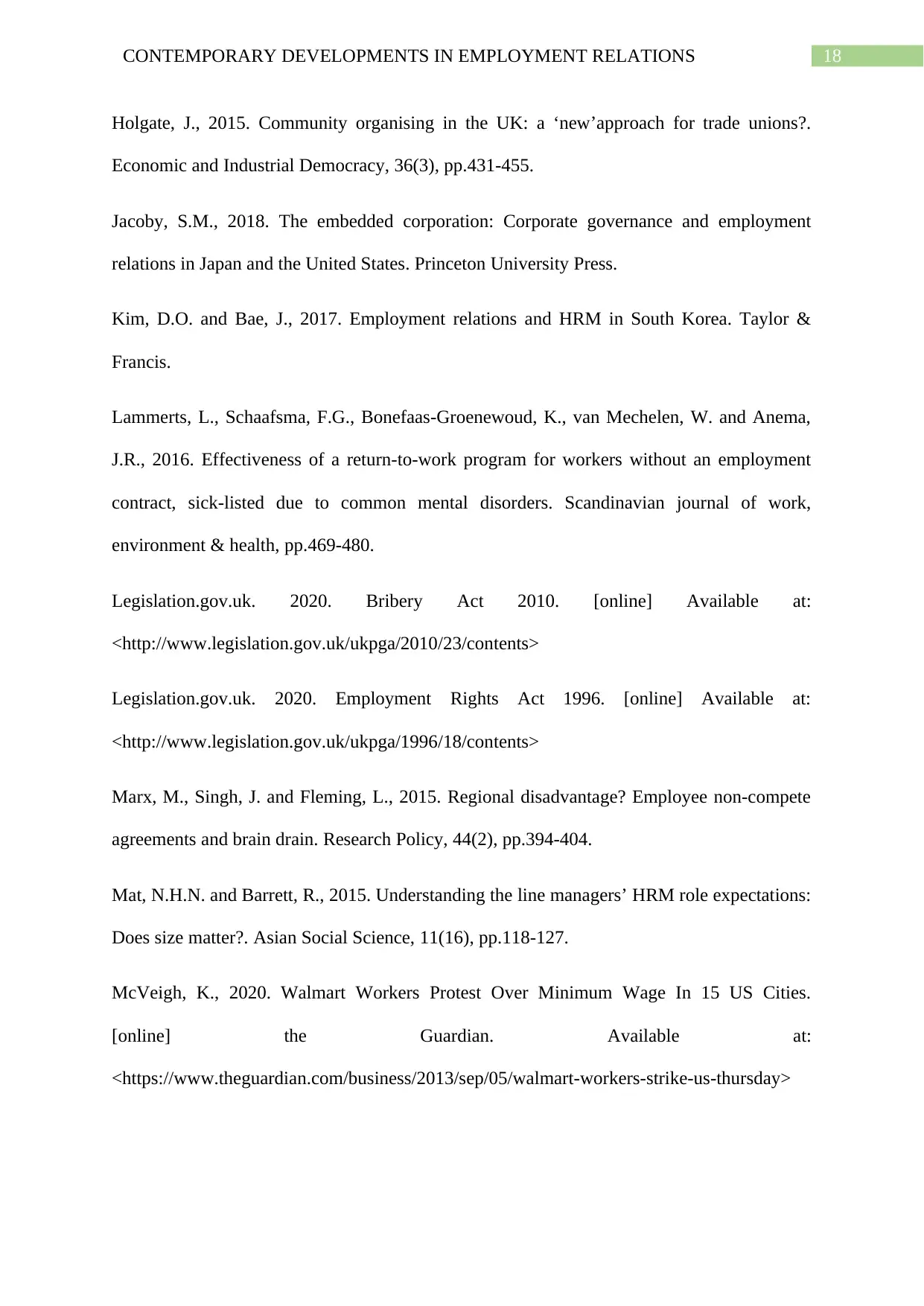
18CONTEMPORARY DEVELOPMENTS IN EMPLOYMENT RELATIONS
Holgate, J., 2015. Community organising in the UK: a ‘new’approach for trade unions?.
Economic and Industrial Democracy, 36(3), pp.431-455.
Jacoby, S.M., 2018. The embedded corporation: Corporate governance and employment
relations in Japan and the United States. Princeton University Press.
Kim, D.O. and Bae, J., 2017. Employment relations and HRM in South Korea. Taylor &
Francis.
Lammerts, L., Schaafsma, F.G., Bonefaas-Groenewoud, K., van Mechelen, W. and Anema,
J.R., 2016. Effectiveness of a return-to-work program for workers without an employment
contract, sick-listed due to common mental disorders. Scandinavian journal of work,
environment & health, pp.469-480.
Legislation.gov.uk. 2020. Bribery Act 2010. [online] Available at:
<http://www.legislation.gov.uk/ukpga/2010/23/contents>
Legislation.gov.uk. 2020. Employment Rights Act 1996. [online] Available at:
<http://www.legislation.gov.uk/ukpga/1996/18/contents>
Marx, M., Singh, J. and Fleming, L., 2015. Regional disadvantage? Employee non-compete
agreements and brain drain. Research Policy, 44(2), pp.394-404.
Mat, N.H.N. and Barrett, R., 2015. Understanding the line managers’ HRM role expectations:
Does size matter?. Asian Social Science, 11(16), pp.118-127.
McVeigh, K., 2020. Walmart Workers Protest Over Minimum Wage In 15 US Cities.
[online] the Guardian. Available at:
<https://www.theguardian.com/business/2013/sep/05/walmart-workers-strike-us-thursday>
Holgate, J., 2015. Community organising in the UK: a ‘new’approach for trade unions?.
Economic and Industrial Democracy, 36(3), pp.431-455.
Jacoby, S.M., 2018. The embedded corporation: Corporate governance and employment
relations in Japan and the United States. Princeton University Press.
Kim, D.O. and Bae, J., 2017. Employment relations and HRM in South Korea. Taylor &
Francis.
Lammerts, L., Schaafsma, F.G., Bonefaas-Groenewoud, K., van Mechelen, W. and Anema,
J.R., 2016. Effectiveness of a return-to-work program for workers without an employment
contract, sick-listed due to common mental disorders. Scandinavian journal of work,
environment & health, pp.469-480.
Legislation.gov.uk. 2020. Bribery Act 2010. [online] Available at:
<http://www.legislation.gov.uk/ukpga/2010/23/contents>
Legislation.gov.uk. 2020. Employment Rights Act 1996. [online] Available at:
<http://www.legislation.gov.uk/ukpga/1996/18/contents>
Marx, M., Singh, J. and Fleming, L., 2015. Regional disadvantage? Employee non-compete
agreements and brain drain. Research Policy, 44(2), pp.394-404.
Mat, N.H.N. and Barrett, R., 2015. Understanding the line managers’ HRM role expectations:
Does size matter?. Asian Social Science, 11(16), pp.118-127.
McVeigh, K., 2020. Walmart Workers Protest Over Minimum Wage In 15 US Cities.
[online] the Guardian. Available at:
<https://www.theguardian.com/business/2013/sep/05/walmart-workers-strike-us-thursday>
Secure Best Marks with AI Grader
Need help grading? Try our AI Grader for instant feedback on your assignments.
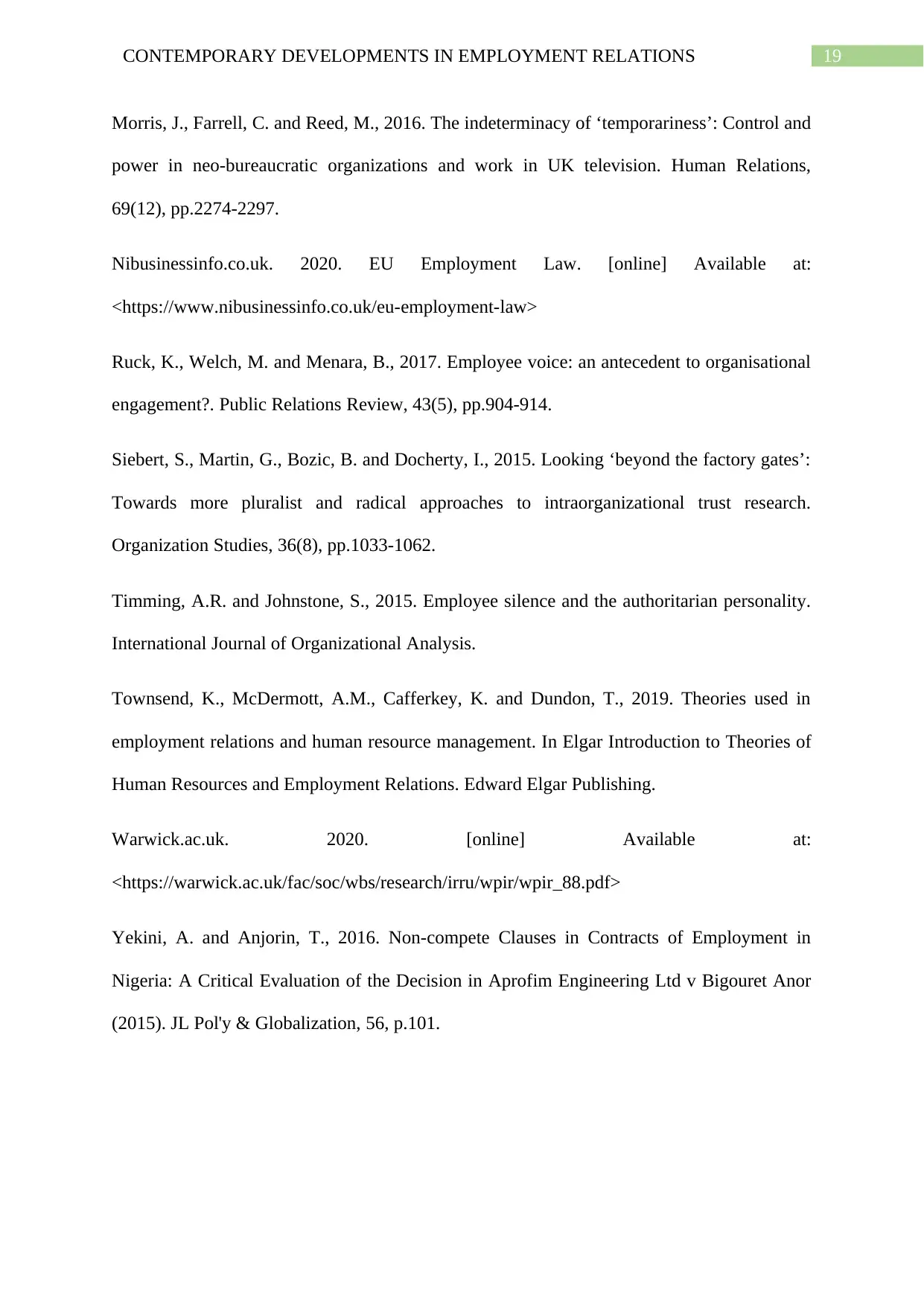
19CONTEMPORARY DEVELOPMENTS IN EMPLOYMENT RELATIONS
Morris, J., Farrell, C. and Reed, M., 2016. The indeterminacy of ‘temporariness’: Control and
power in neo-bureaucratic organizations and work in UK television. Human Relations,
69(12), pp.2274-2297.
Nibusinessinfo.co.uk. 2020. EU Employment Law. [online] Available at:
<https://www.nibusinessinfo.co.uk/eu-employment-law>
Ruck, K., Welch, M. and Menara, B., 2017. Employee voice: an antecedent to organisational
engagement?. Public Relations Review, 43(5), pp.904-914.
Siebert, S., Martin, G., Bozic, B. and Docherty, I., 2015. Looking ‘beyond the factory gates’:
Towards more pluralist and radical approaches to intraorganizational trust research.
Organization Studies, 36(8), pp.1033-1062.
Timming, A.R. and Johnstone, S., 2015. Employee silence and the authoritarian personality.
International Journal of Organizational Analysis.
Townsend, K., McDermott, A.M., Cafferkey, K. and Dundon, T., 2019. Theories used in
employment relations and human resource management. In Elgar Introduction to Theories of
Human Resources and Employment Relations. Edward Elgar Publishing.
Warwick.ac.uk. 2020. [online] Available at:
<https://warwick.ac.uk/fac/soc/wbs/research/irru/wpir/wpir_88.pdf>
Yekini, A. and Anjorin, T., 2016. Non-compete Clauses in Contracts of Employment in
Nigeria: A Critical Evaluation of the Decision in Aprofim Engineering Ltd v Bigouret Anor
(2015). JL Pol'y & Globalization, 56, p.101.
Morris, J., Farrell, C. and Reed, M., 2016. The indeterminacy of ‘temporariness’: Control and
power in neo-bureaucratic organizations and work in UK television. Human Relations,
69(12), pp.2274-2297.
Nibusinessinfo.co.uk. 2020. EU Employment Law. [online] Available at:
<https://www.nibusinessinfo.co.uk/eu-employment-law>
Ruck, K., Welch, M. and Menara, B., 2017. Employee voice: an antecedent to organisational
engagement?. Public Relations Review, 43(5), pp.904-914.
Siebert, S., Martin, G., Bozic, B. and Docherty, I., 2015. Looking ‘beyond the factory gates’:
Towards more pluralist and radical approaches to intraorganizational trust research.
Organization Studies, 36(8), pp.1033-1062.
Timming, A.R. and Johnstone, S., 2015. Employee silence and the authoritarian personality.
International Journal of Organizational Analysis.
Townsend, K., McDermott, A.M., Cafferkey, K. and Dundon, T., 2019. Theories used in
employment relations and human resource management. In Elgar Introduction to Theories of
Human Resources and Employment Relations. Edward Elgar Publishing.
Warwick.ac.uk. 2020. [online] Available at:
<https://warwick.ac.uk/fac/soc/wbs/research/irru/wpir/wpir_88.pdf>
Yekini, A. and Anjorin, T., 2016. Non-compete Clauses in Contracts of Employment in
Nigeria: A Critical Evaluation of the Decision in Aprofim Engineering Ltd v Bigouret Anor
(2015). JL Pol'y & Globalization, 56, p.101.
1 out of 20
Related Documents
Your All-in-One AI-Powered Toolkit for Academic Success.
+13062052269
info@desklib.com
Available 24*7 on WhatsApp / Email
![[object Object]](/_next/static/media/star-bottom.7253800d.svg)
Unlock your academic potential
© 2024 | Zucol Services PVT LTD | All rights reserved.




